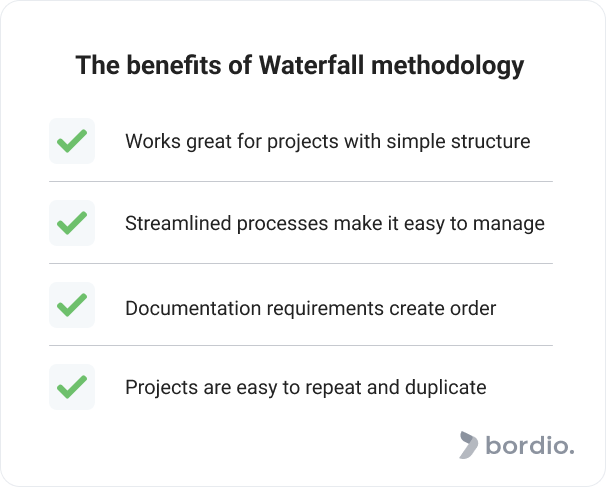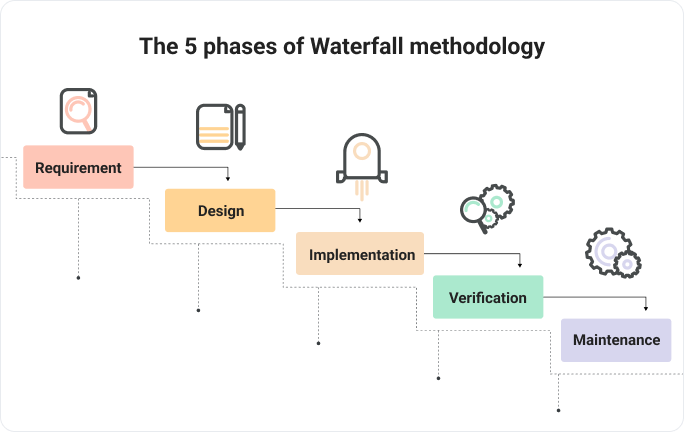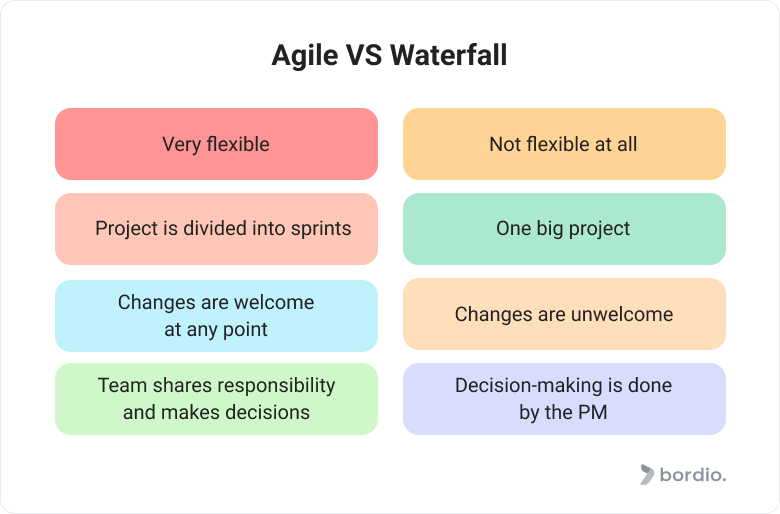The Waterfall project management method has once been on trend, but eventually became overshadowed by Agile, Scrum, Lean, PRINCE2, and Kanban.
Nonetheless, contrary to popular belief in the IT crowd, Waterfall is still used by many teams across different fields. And just like all project management methodologies, Waterfall has its strong sides, so today we will tell you all about:
- The main principles of Waterfall.
- What Waterfall method consists of.
- The good and the bad in the Waterfall process.
What is the Waterfall methodology?
Waterfall is a project management framework or style, if you will, that relies on a linear approach to getting things done. It is often planned using a Gantt chart.
The name “waterfall” symbolizes the sequential process that flows like a waterfall.
Such an approach makes every step of the way clear and transparent, allowing to better execute and manage the project.
Waterfall methodology is a great framework for projects where there are lots of repetitive processes and little room for variation, like in the manufacturing and construction industries. It also works great when the uncertainties are low in general, for example, if requirements are 100% clear from the beginning.
EXAMPLE: Let’s take an example of house construction where Waterfall methodology would fit very well and the Agile project management approach wouldn’t make so much sense.
Let’s say we are building a house from scratch:
-
First, we start by identifying what we want and creating a requirements document: how many bedrooms we want, will we have one or two floors.
-
Next, the project design phase begins where the architect creates the future house model.
-
Once the project plan is finished, it is approved by the client, and permits are requested from all local regulators.
-
And finally, after permits are granted, we can start the implementation phase where, once again, we follow strict rules: first we do the basement, next we put up walls, and the roof comes last.
Now, if it were a tech Agile project, then we would expect to be able to request changes at any point in the software development life cycle. It could look like a client asking to add an extra bathroom after all permits were received and the basement was already finished. Naturally, that wouldn’t work so well. So, while the Agile method would make sense in software development, it wouldn’t be helpful in construction.
The benefits of Waterfall methodology
The Waterfall model can really work great for projects with simple structures.
Besides that the Waterfall project management methodology has several benefits:
Simplicity
The clear and easy-to-grasp structure makes projects easy to manage especially when we use the schedule calendar maker in conjunction with this method. Streamlined processes leave little room for confusion, and with the project tasks clearly outlined in team’s online calendar planners, it’s harder to miss something important. This makes the Waterfall method a great choice for project managers with little experience – they are already stressed with all PM roles and responsibilities that they need to manage simultaneously. Removing the complicated project framework means one less thing for them to worry about, and that’s already something! Therefore, we highly recommend using this pedodic and try using different task planners.
Tidiness
Waterfall methodology doesn’t leave a mess behind like some Agile development projects do because Waterfall relies heavily on documentation. Each step is checked and documented before the next phase begins. It means that if anything needs to be looked back or double-checked, the data is there and it can easily be done.
The detailed documentation process might not sound like a particular benefit but it makes a big difference. Tons of projects worldwide get delivered chaotically with little to no reports and paperwork. And if someone who wasn’t originally engaged in the project needs to change or find something, this causes issues and creates risks for the product and the company.
Easy to duplicate
Waterfall projects are easy to repeat and imitate. With all steps clearly outlined and well-documented, it becomes rather easy to standardize the entire process and repeat it later with the next project. It will be even easier if you have all the information saved about the projects in your free online planner.
Say if you have a construction company that builds similar townhouses around the country, being able to get almost like a template for your future projects means potentially enormous cost savings and a much better reputation on the market.
The downsides of Waterfall methodology
Of course, nothing is perfect in this world, and Waterfall project management methodology has its own downsides too. Let’s look at the main ones.
Minimal flexibility
If somewhere along the way a change happens and our originally planned product becomes partially or completely obsolete, it’s going to cost a lot of time and money to correct that without a guarantee of success.
EXAMPLE: If we go back to our house construction example, it is extremely inflexible once the house project is approved and the papers are finalized. If our client comes back to us before the construction starts and asks to re-do the second floor because they just found out that they are having twins, the entire project and permits will have to be started from scratch. Naturally, it will cost a lot of money and take a lot of time to implement the new requirements.
In a different example of website development, we see the same logic and issues. Websites are also mostly created with Waterfall methodology as first we work out the requirements, then design the interface and logic, and only after that, the development process starts.
If somewhere in the middle of the work shareholders want to change how the website operates, it can either be changed relatively easily or become a huge issue depending on the platform and programming languages that are used by the project team.
Documenting takes time
Proper reporting and documentation is not a fast task. And if the entire project team waits for the papers to be ready before they proceed with the next task in the online day planners, the waste of resources piles up rather quickly. Even for a team weekly schedule planner, it’s not going to be fast.
Depending on your project requirements, having some downtime to fill in the papers might not be that big of a deal. Not every project needs to be rushed, although they all usually seek ways to reduce the timeframe and get to the release stage faster. If you are working in software development you’re likely to see a slow documentation process as a risk. With the website development process or house construction, there is typically less urgency.
It is important to note though that because Waterfall methodology is so obedient and follows the rules, all data and processes are usually logged in the system in real-time, making the documenting process not that hard. Especially if teams use productivity and online to-do list software, like Bordio, where the information is already well-structured and provided in a report-friendly format. So we recommend trying out best schedule builder from Bordio.
Shareholders are excluded
The traditional Waterfall approach excludes clients and/or shareholders from the internal processes of the project.
While it can be a blessing to not have constant interruptions and u-turns, in general, having the actual end-user have an occasional peek and tell you what’s good and what needs adjustment is beneficial to the quality end-product and client satisfaction.
Testing is performed at the end
The testing phase happens at the very end of the project. It means that any bugs or issues that could have been fixed within a couple of hours a month ago, will take much longer now. And that is the best-case scenario! Some of those issues and incompatibilities can be unfixable and detrimental to the project if they’re not spotted in the early stages.
The 5 phases of Waterfall project management
Waterfall divides the project management into 5 key phases: requirements, design, implementation, verification, and maintenance. The previous phase must be completely done before the project management team can move on to the next one.
The steps below resemble the typical Waterfall methodology project life cycle.
#1 Requirement
The main task here is to identify requirements and assess the project’s viability. Here, the project manager gets heavily involved with shareholders who would not be as active later on in the project.
During the requirements phase we:
- Set project objectives: what do we want to achieve? What is the end goal? Use a task tracker for teams to set the tasks for others.
- Draft the project scope: preliminary timeframes, budgets, and costs.
- Do the risk evaluation: list all risks possible and create a mitigation plan for each.
- Do market research if necessary – you can use saas marketing firms to make it easyer. Sometimes projects are suggested by shareholders who don’t have enough data to prove it’s a valid idea. In that case, we run research to ensure the time and funds won’t be wasted and there is real demand out there.
- Assemble the project team if not yet available. In project management, the team is often there already. Yet sometimes we need to find a few more team members with the required expertise. In rare cases, a PM will put the team together from scratch. PM could try to implement time management systems, that will increase control over work.
#2 Design
The next phase is design. Here we create a detailed project plan and start assigning the tasks in everyone’s digital weekly planners.
We involve team members and ask for their expert input.
The key aspects that are identified and finalized at the design phase are project schedule, milestones that will benchmark the progress, deliverables, and deadlines.
It is at the design phase that we begin to understand what the final product or service will look like and what is needed to get there.
#3 Implementation
Unlike the previous phase, implementation is all about doing the work. At this point in Waterfall projects, we start bringing the concept to life. We track progress and compare it against milestones and KPIs, monitor risks and bottlenecks that might come up during the active phase.
In a software development project, the implementation phase is when the coding begins. In house construction, that’s when we start digging the holes and pouring concrete.
#4 Verification
The verification phase is arguably the most nerve-wracking in the entire project.
The main goal of this Waterfall project management stage is to test and check that everything works as planned and results are satisfactory. All initially identified problems must be solved by the created solution, and the overall quality must be high.
It’s best to include user tests and compliance checks (if applicable, like with fintech products and construction) in the verification phase.
Remember: finishing the project is great, but it must work as planned before you get to celebrate.
#5 Maintenance
The final maintenance phase of the Waterfall method will look different based on the agreements and the nature of the product but the main activities here would be the following:
- Fixing bugs and issues that were spotted later by clients.
- Minor improvements to boost the performance and keep the solution up to date.
You also need to go over the quality of completed tasks from your electronic planner. The maintenance phase relies heavily on customer feedback and insights from the real-world experience. No matter how much quality control went into the development life cycle, we cannot predict everything.
Pro tip: Don’t be shy to add more steps to the existing Waterfall methodology phases but make sure you include the five basic ones to ensure the proper Waterfall process.
What differentiates Waterfall from Agile?
Waterfall methodology and Agile methodology have some similarities but they are two very different project management ideologies.
Here are the key differences between the Agile approach and the Waterfall method:
-
Agile is extremely flexible. Waterfall is very well-organized and plan-obedient.
-
Agile divides the project into sprints, where each sprint is a mini-project on its own with every step of development and a series of scrum meetings, such as backlog refinement and sprint retrospective, held during that period. The waterfall method divides the project into precise phases. So, Agile teams will do implementation and verification within every sprint, whereas Waterfall, for example, does all the implementation before moving on to the verification phase.
-
With Agile, changes can be made at any point and their negative impact is minimized. With Waterfall, nothing is changed after the design phase.
-
Agile is all about iteration. The waterfall model is all about repeating a once standardized process over and over again.
-
The agile team (aka the development team) is interchangeable, everyone shares the responsibilities, and project managers (aka product owners in Agile) are not essential to the project’s success. In Waterfall, hierarchy is much more important and project managers hold a lot of decision-making power.
Sometimes people try to adopt Agile in every single project they do because it’s trendy and cool, and all the big tech giants who know what’s up use it.
However, in some industries, like construction or marketing, Waterfall project management is a much better option. Tip: If you don’t want to understand marketing techniques on your own, you can use the services of startup marketing companies.
It is important to note that because Agile is a very flexible framework, it can be twisted and adjusted to fit the company’s individual needs. And while the Waterfall model is very formal and procedures are rather non-flexible, it too can be changed up if necessary.
So if you are looking to implement one or the other, remember that while it is recommended to follow the main principles of each framework to ensure it works as it should, you can also make the methodology your own and adapt it accordingly.








